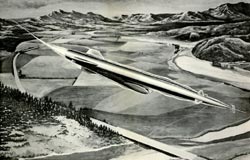|
|||||||
|
Muscle in Mothballs
The program was terminated in July 1964 by the Department of Defense and the State Department as “being too provocative”. It was believed by many that if the U.S. deployed a missile of such awesome power against which there was no known defense, then the Soviets would be compelled to do so. At the end of the project, Chance Vought had 177 engineers and scientists involved in the program full time. It was called “a model technology program” by the Department of Defense. Much of the technology, especially that of the guidance system, TERCOM, is utilized in the cruise missile that is part of today’s arsenal of U.S. weapons. SLAM Description: Airframe |

 All the major areas had been investigated by mid-1964 and the feasibility of nuclear flight was firmly established, laying a foundation for proceeding with a detailed design and flight test. But the world was beginning to change with the Cuban missile crisis in the past, the development of long-range ballistic missiles, and the advent of space exploration. The concept of releasing radioactive fission products in the atmosphere in any locale was being rejected as more was learned of the effects of their release.
All the major areas had been investigated by mid-1964 and the feasibility of nuclear flight was firmly established, laying a foundation for proceeding with a detailed design and flight test. But the world was beginning to change with the Cuban missile crisis in the past, the development of long-range ballistic missiles, and the advent of space exploration. The concept of releasing radioactive fission products in the atmosphere in any locale was being rejected as more was learned of the effects of their release.